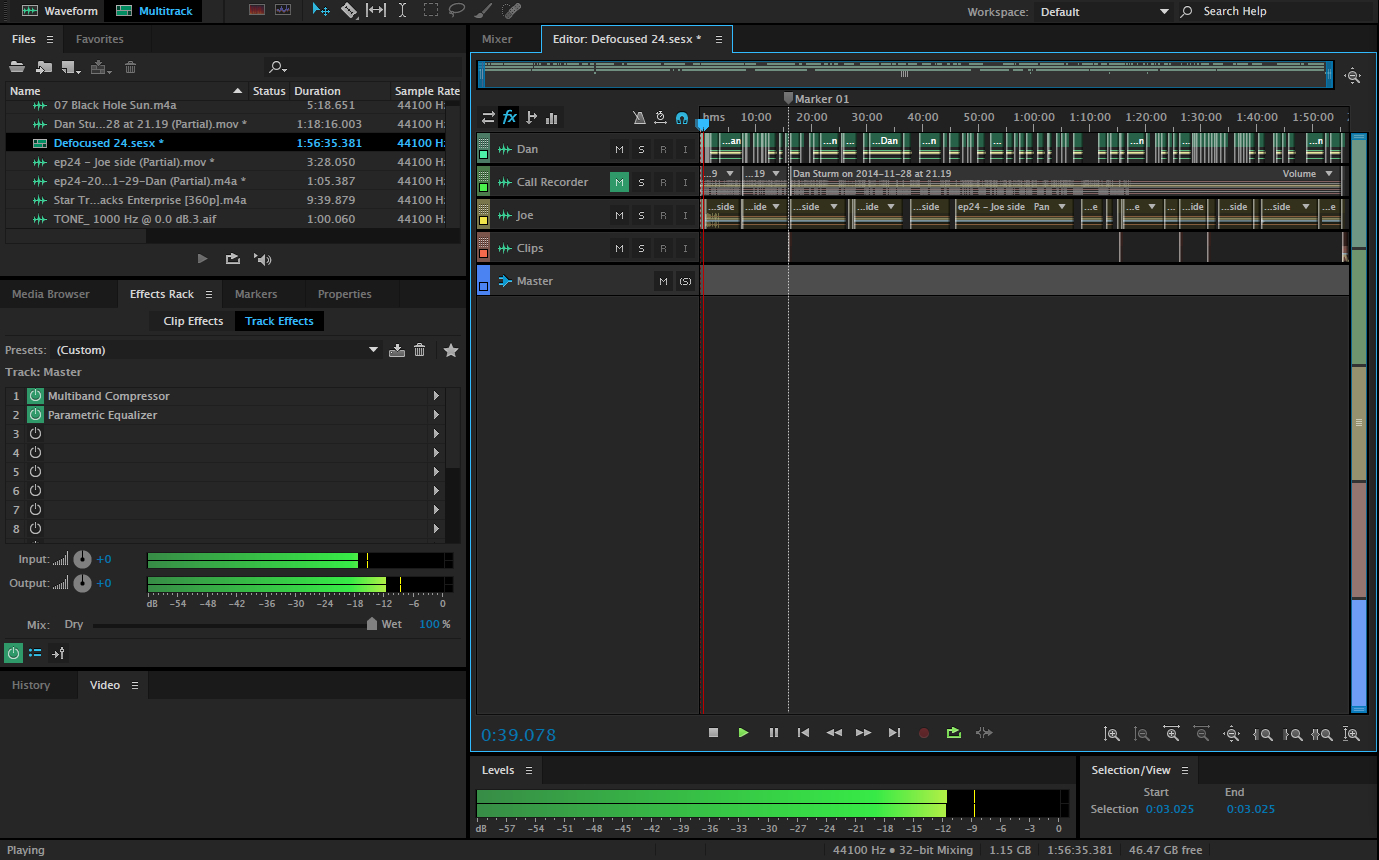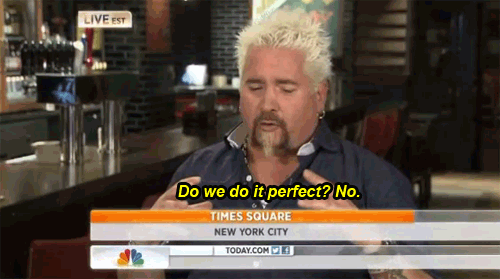How We Make Podcasts
Casey Liss posted last week about his podcasting setup. This went on to inspire some spirited discussion about microphones, and how people should be encouraging, and not exclusionary, with their podcasting recommendations. What is a pro? What is art? What is the nature of the universe? Is this real life?
Ahem.
I seldom get asked about my podcasting setup, but there are a few things that are different about what we do that might be interesting to someone.
(Crickets chirping.)
Mein Mikrofon
I use the much-reviled Blue Yeti microphone. If you are an audiophile, you have feelings about this. It is an imperfect device, but it fills the role I need it to, for the money I’m comfortable spending. If you seek advice on creating a podcasting empire with the dulcet tones of your voice, look elsewhere for advice. I do not excuse the Yeti, or say that it is good enough for anyone, it is simply appropriate for my specific situation. Should I ever fall face-first on a pile of money I will wash my face, because money is dirty, but then I will spend the money on some gear.
Pros:
- Relatively inexpensive, and frequently on sale through various retailers.
- USB interface makes it a breeze to use.
- Headphone jack input on the device allows me to hear what the microphone is picking up while I record, and to hear Skype calls.
- Physical mute switch that I forget to disable every time I plug in the Yeti.
Cons:
- Everyone freaks out that you use a Blue Yeti.
- It comes with a weird stand that is not effective because it’ll be on a table, or desk, in front of you and pick up every vibration from you contacting the table or desk.
- Most people replace this silly stand with something more professional, perhaps on a boom arm, or tripod.
- I have a hand towel that’s folded over on itself that acts as a shock absorber. Cry your little tears, audiophiles!
- The Yeti is very sensitive to any noise around you. Street noise, a refrigerator in another room, loud neighbors, etc. I do record in less-than-ideal circumstances for this kind of device, and we have had interruptions in our recording because of it. Your mileage will vary.
On the Line
Like many podcasts, Dan and I use Skype to call one another, and then each of us records our ends of the conversations. Referred to as a double-ender (snicker). When we started, Dan and I used QuickTime to record the audio input that was being used for the Skype call. QuickTime does this for free, but you have to remember to launch and start, and stop, the recording.
One time, I opened QuickTime before I plugged in my USB microphone, so QuickTime didn’t see it as an input and recorded the system microphone on my MacBook Pro. That is not so good. After this incident, Jason Snell recommended Skype Call Recorder to me. I hemmed and hawed about spending money on it, since I didn’t technically need it, but it’s worth the piece of mind to buy Call Recorder. Having used it for months now, I can safely say that I recommend it, even if you’re just starting. You’ll just feel safer about your recordings, with is worth the cost of the software.
Cutting Room Floor
Dan and I both come from backgrounds in video, and film. We both believe in editing podcasts. The degree to which a podcast is edited can vary, but our edits generally consist of:
- Removing garbage from someone hitting a table, or a water bottle (unless it’s not possible to safely extract, so it’s another reason to be mindful while recording.) In a screenshot below you’ll see how much stuff gets scrapped out when we’re not speaking.
- Trimming start and ends. Most of the time, Dan and I launch right in to the show at the start of the call, unless it’s a call with a guest. We stay on the line a little at the end, and remove part of that. “Not editing for content” doesn’t mean you literally leave in every second of recording.
- Recordings get out sync as time goes on. It usually just requires a quick cut with the razor and slipping the track a bit.
- We do edit for content. If you listen, you’ll hear us flub a lot of stuff, so it’s not really editing to make us sound better, but we might remove a small aside about something for the episode, or excise a bit that didn’t come out like we meant it to. It’s really not anything crazy. We aren’t manufacturing a pristine illusion of two intelligent, funny guys, that would be a lie.
- Flare. This is my favorite part. Early in our podcast’s life, Dan started inserting little bits of audio for pop culture references (I am not a lawyer, but totes fair use). On the two occasions I’ve taken on editing duties, I’ve tried to emulate this. Usually with music that stops at just-not-quite-the-right time. Last night, Dan didn’t get “very cold in space”, so I spliced in some audio and left a huge spike of music before it cuts back to him talking about how unimportant it is that he get the reference. That’s something you can do in editing, for comedy. Shows like Bionic/BONANZA! have a system where Myke can play live audio in the call because of his mixer. This is some on-the-fly editing.
- Bleeps. We try to edit bad words so we don’t have to have an explicit tag. The bleeps kind of come out funny, in their own way. Especially if you’re playing a game of not actually saying a bad word.
Editing Software
Dan uses Soundtrack Pro to edit almost every episode. I do not know much of the process, because I’ve never seen him edit anything, and I’ve never used Soundtrack Pro.
The two times I’ve edited the podcast, for Galaxy Quest and Interstellar, I went with Adobe Audition CC 2014 (just rolls of the tongue). I had an existing relationship with Adobe that made this tool appealing to use. Almost every podcaster uses Logic Pro to do their work, so please don’t place a purchasing decision on me editing two episodes in something that was convenient for me.
The application is similar to Premiere, which I’ve had experience with in the past at school, and for cutting my demo reels. The tools it has for adjusting audio are great, but it’s not as easy to manage a 2 hour clip of audio as I would like it to be. Also? I spent an hour trying to figure out why variable-bit-rate encoding was producing files of different sizes and lengths before I went with constant-bit-rate and sent the file to Dan to compress further.
Here’s our episode on Interstellar:

Review
We review the episodes we record. Sometimes, we listen to the raw Call Recorder version, and sometimes we listen to rough cuts. In some situations we spot-check episodes instead of listening to the whole thing over again 1:1. We rely on a shared Dropbox folder for this. Recordings go in to it, and a “Review” folder displays the latest episode being worked on. The Dropbox app on iOS allows us to listen to the episodes while we go about our lives.
Slacking
From before we start an episode, until after an episode ships, we use Slack to discuss things, and keep things organized. Currently, we use the free account to do this. We have different rooms for different kinds of conversation, and we use them to handle things like shownotes, and title suggestions. Crucially, this is where we decide when to record, and agree to a topic to discuss. It would not be possible to manage the podcast without a real-time chat app with dedicated areas for different discussions.
The All-In-One Platform You Need
Dan uses a Squarespace account to manage the show’s site. This includes managing the RSS feed for the podcast, and the published shownotes. It doesn’t serve our audio files. This is far easier than some moron trying to write RSS stuff themselves.
To Serve Man
Perhaps the most unique aspect of our show is hosting the audio files on my specific server configuration. Most podcasts use LibSyn, or Soundcloud, or some fancy content caching system. In an effort to not spend any money, we decided to use my existing VPS to handle our podcast. I was concerned it would be overwhelmed, but it’s been over twenty episodes and we’ve never had an incident of it going down.
DigitalOcean’s $5/month VPS serves everything. A single droplet, running Ubuntu, with the Twisted framework serving static files. VFX software integrates Python 2.7.x stuff for scripting things so Twisted is just easier for me to deal with than Apache. When I first started blogging on this VPS, I used Python’s SimpleHTTPServer to handle things and a strong breeze would knock it over. Twisted is solid. My datacenter is in San Francisco, and there was one time Casey Liss experienced latency that I could not reproduce, so it may not work for every possible person ever, but it’s certainly affordable, and very flexible. Also, who cares about Casey?
To upload files, I use Panic’s Transmit on the Mac, and iOS. Yes, the iOS app is robust enough that I can download the file from the review folder in the Dropbox iOS app and upload it through the Transmit iOS app.
We have no sponsors, so we aren’t investing in an analytics platform. I have written a python script that allows me to open the access logs from Twisted and count the number of times that a file is download from a unique IP address, each day. I use Panic’s Prompt on iOS to run this on the logs on the server.
When I’ve uploaded the file, I send Dan the path and he puts it in with the shownotes and pushes out an update to the feed.
JIFs
Infrequently, I make silly images to promote the show. Sometimes, they are animated GIFs of someone’s face very loosely tracked on to a short clip from a movie. I have a license of Apple’s old compositing software, Shake, from a short project. I use it to generate a short video, and then I take that in to GIFBrewery where I adjust some knobs to generate a GIF. It’s not a technically impressive task, but a few people have asked how we do it. I would not recommend anyone reproduce this workflow, because Shake stops working on any version of OS X higher than Mavericks.
Content is King
Content is such a buzzword, but it’s appropriate shorthand to cover the variety of things that can be in a podcast. Sound, music, vocal ticks, words, even silence is part of the content. No one will ever tell you how to be interesting, and there will never be a guide on it. Dan and I certainly don’t appeal to everyone, but we’ve carved out what we like to do, and the small audience we like to do it for. We might have a casual tone on the podcast, but we do care about what we make.

Dan and I threw away hours of audio recordings from before we even knew what we wanted the show to be. Even then, it changed over time. No one has a guide for that.
An Explanation, Not a Guide
To be very clear about something: I am not telling you to do what Dan and I do. This explains what we do. Do what you will with the information. (You should probably do nothing with it!)
Category: text